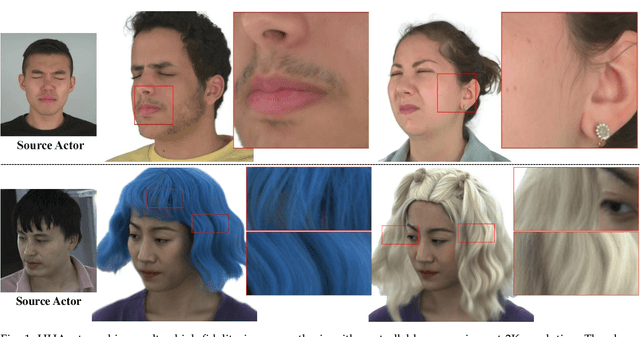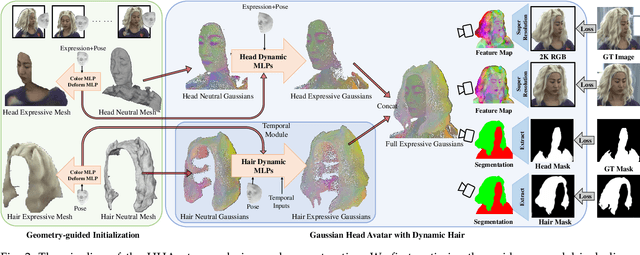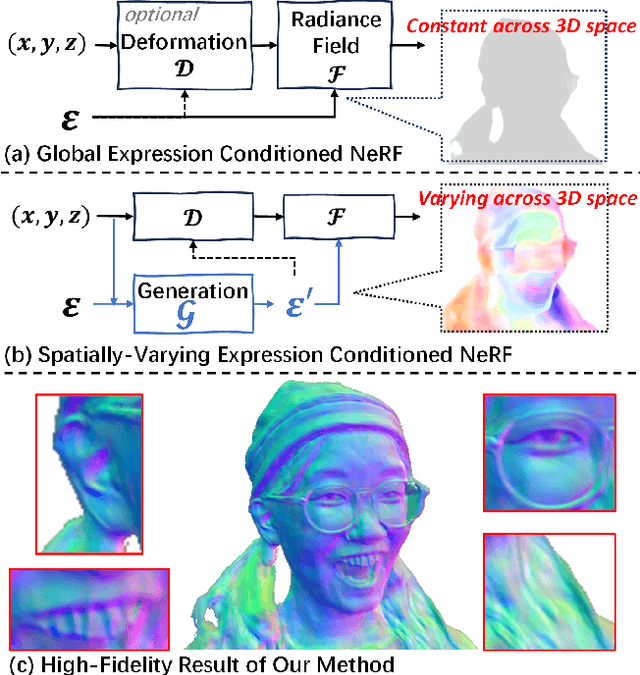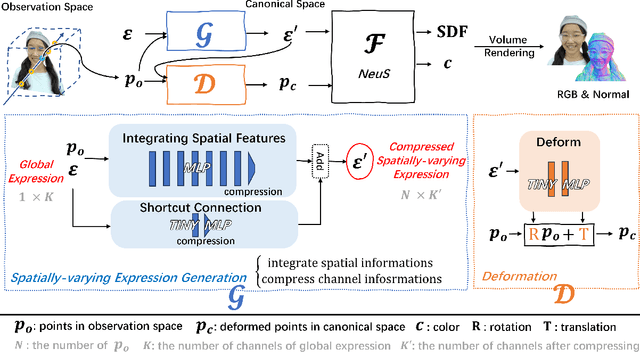Yuelang Xu
Tsinghua University, Simon Fraser University
3D Gaussian Parametric Head Model
Jul 21, 2024



Abstract:Creating high-fidelity 3D human head avatars is crucial for applications in VR/AR, telepresence, digital human interfaces, and film production. Recent advances have leveraged morphable face models to generate animated head avatars from easily accessible data, representing varying identities and expressions within a low-dimensional parametric space. However, existing methods often struggle with modeling complex appearance details, e.g., hairstyles and accessories, and suffer from low rendering quality and efficiency. This paper introduces a novel approach, 3D Gaussian Parametric Head Model, which employs 3D Gaussians to accurately represent the complexities of the human head, allowing precise control over both identity and expression. Additionally, it enables seamless face portrait interpolation and the reconstruction of detailed head avatars from a single image. Unlike previous methods, the Gaussian model can handle intricate details, enabling realistic representations of varying appearances and complex expressions. Furthermore, this paper presents a well-designed training framework to ensure smooth convergence, providing a guarantee for learning the rich content. Our method achieves high-quality, photo-realistic rendering with real-time efficiency, making it a valuable contribution to the field of parametric head models.
Gaussian Head Avatar: Ultra High-fidelity Head Avatar via Dynamic Gaussians
Dec 05, 2023



Abstract:Creating high-fidelity 3D head avatars has always been a research hotspot, but there remains a great challenge under lightweight sparse view setups. In this paper, we propose Gaussian Head Avatar represented by controllable 3D Gaussians for high-fidelity head avatar modeling. We optimize the neutral 3D Gaussians and a fully learned MLP-based deformation field to capture complex expressions. The two parts benefit each other, thereby our method can model fine-grained dynamic details while ensuring expression accuracy. Furthermore, we devise a well-designed geometry-guided initialization strategy based on implicit SDF and Deep Marching Tetrahedra for the stability and convergence of the training procedure. Experiments show our approach outperforms other state-of-the-art sparse-view methods, achieving ultra high-fidelity rendering quality at 2K resolution even under exaggerated expressions.
High-Fidelity 3D Head Avatars Reconstruction through Spatially-Varying Expression Conditioned Neural Radiance Field
Oct 10, 2023



Abstract:One crucial aspect of 3D head avatar reconstruction lies in the details of facial expressions. Although recent NeRF-based photo-realistic 3D head avatar methods achieve high-quality avatar rendering, they still encounter challenges retaining intricate facial expression details because they overlook the potential of specific expression variations at different spatial positions when conditioning the radiance field. Motivated by this observation, we introduce a novel Spatially-Varying Expression (SVE) conditioning. The SVE can be obtained by a simple MLP-based generation network, encompassing both spatial positional features and global expression information. Benefiting from rich and diverse information of the SVE at different positions, the proposed SVE-conditioned neural radiance field can deal with intricate facial expressions and achieve realistic rendering and geometry details of high-fidelity 3D head avatars. Additionally, to further elevate the geometric and rendering quality, we introduce a new coarse-to-fine training strategy, including a geometry initialization strategy at the coarse stage and an adaptive importance sampling strategy at the fine stage. Extensive experiments indicate that our method outperforms other state-of-the-art (SOTA) methods in rendering and geometry quality on mobile phone-collected and public datasets.
LatentAvatar: Learning Latent Expression Code for Expressive Neural Head Avatar
May 03, 2023Abstract:Existing approaches to animatable NeRF-based head avatars are either built upon face templates or use the expression coefficients of templates as the driving signal. Despite the promising progress, their performances are heavily bound by the expression power and the tracking accuracy of the templates. In this work, we present LatentAvatar, an expressive neural head avatar driven by latent expression codes. Such latent expression codes are learned in an end-to-end and self-supervised manner without templates, enabling our method to get rid of expression and tracking issues. To achieve this, we leverage a latent head NeRF to learn the person-specific latent expression codes from a monocular portrait video, and further design a Y-shaped network to learn the shared latent expression codes of different subjects for cross-identity reenactment. By optimizing the photometric reconstruction objectives in NeRF, the latent expression codes are learned to be 3D-aware while faithfully capturing the high-frequency detailed expressions. Moreover, by learning a mapping between the latent expression code learned in shared and person-specific settings, LatentAvatar is able to perform expressive reenactment between different subjects. Experimental results show that our LatentAvatar is able to capture challenging expressions and the subtle movement of teeth and even eyeballs, which outperforms previous state-of-the-art solutions in both quantitative and qualitative comparisons. Project page: https://www.liuyebin.com/latentavatar.
ManVatar : Fast 3D Head Avatar Reconstruction Using Motion-Aware Neural Voxels
Nov 23, 2022Abstract:With NeRF widely used for facial reenactment, recent methods can recover photo-realistic 3D head avatar from just a monocular video. Unfortunately, the training process of the NeRF-based methods is quite time-consuming, as MLP used in the NeRF-based methods is inefficient and requires too many iterations to converge. To overcome this problem, we propose ManVatar, a fast 3D head avatar reconstruction method using Motion-Aware Neural Voxels. ManVatar is the first to decouple expression motion from canonical appearance for head avatar, and model the expression motion by neural voxels. In particular, the motion-aware neural voxels is generated from the weighted concatenation of multiple 4D tensors. The 4D tensors semantically correspond one-to-one with 3DMM expression bases and share the same weights as 3DMM expression coefficients. Benefiting from our novel representation, the proposed ManVatar can recover photo-realistic head avatars in just 5 minutes (implemented with pure PyTorch), which is significantly faster than the state-of-the-art facial reenactment methods.
PIE-NET: Parametric Inference of Point Cloud Edges
Jul 09, 2020



Abstract:We introduce an end-to-end learnable technique to robustly identify feature edges in 3D point cloud data. We represent these edges as a collection of parametric curves (i.e.,lines, circles, and B-splines). Accordingly, our deep neural network, coined PIE-NET, is trained for parametric inference of edges. The network relies on a "region proposal" architecture, where a first module proposes an over-complete collection of edge and corner points, and a second module ranks each proposal to decide whether it should be considered. We train and evaluate our method on the ABC dataset, a large dataset of CAD models, and compare our results to those produced by traditional (non-learning) processing pipelines, as well as a recent deep learning based edge detector (EC-NET). Our results significantly improve over the state-of-the-art from both a quantitative and qualitative standpoint.
 Add to Chrome
Add to Chrome Add to Firefox
Add to Firefox Add to Edge
Add to Edge